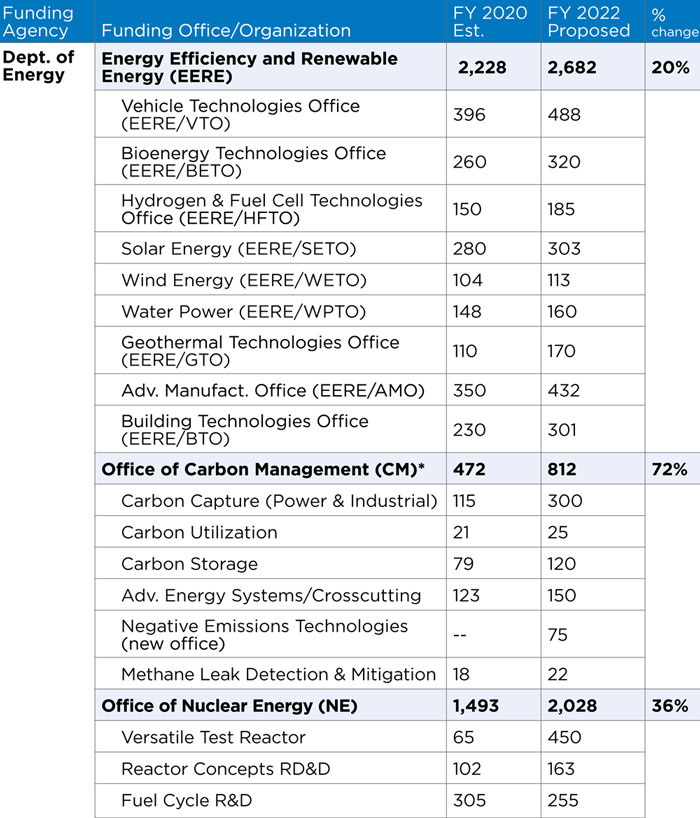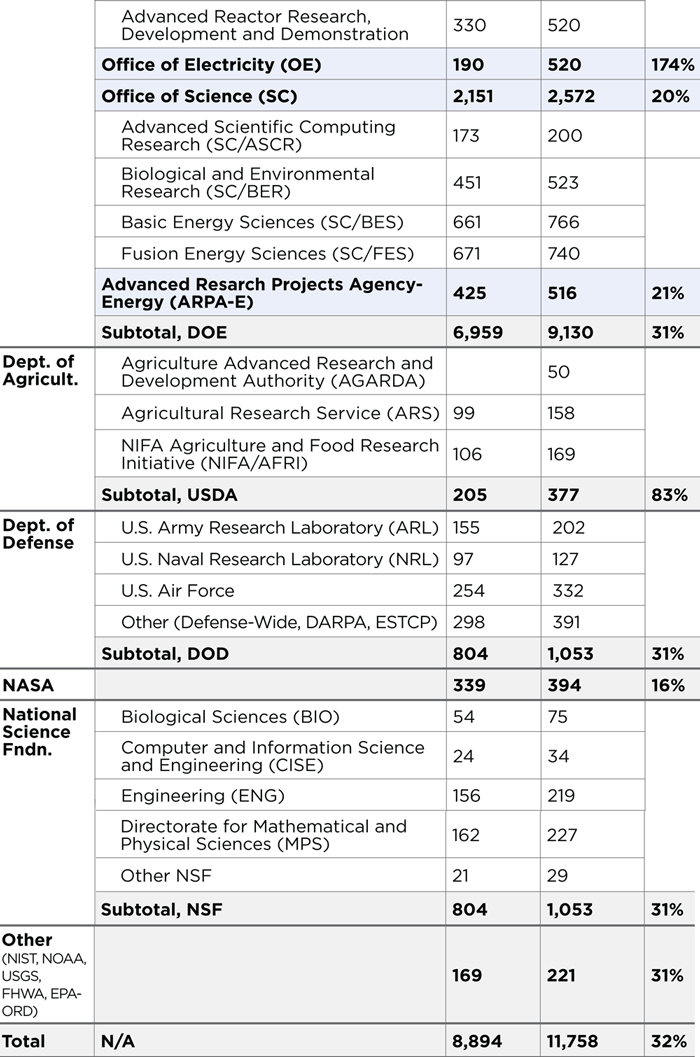Energizing America: A Roadmap to Launch a National Energy Innovation Mission

Clean energy innovation is central to the fight against climate change. The dramatic success in lowering the costs of solar panels and wind turbines in the past decade must be replicated across a wide range of other energy technologies. Doing so will open extraordinary economic opportunities.
To rise to this challenge, the United States should launch a National Energy Innovation Mission. Led by the president and authorized by Congress, this mission should harness the nation’s unmatched innovative capabilities—at research universities, federal laboratories, and private firms (both large and small), in all regions of the country—to speed the progress of clean energy technologies. To jumpstart this mission and unlock a virtuous cycle of public and private investment, the US federal government should triple its funding for energy research, development, and demonstration (RD&D) over the next five years.
| Ed. Note: This research, co-authored by ITIF and the Center on Global Energy Policy at Columbia University’s School of International & Public Affairs (SIPA), is cross-posted here with the Center’s permission. For more, visit the microsite, and order a paperback. |
Although a growing bipartisan chorus is calling for more ambitious public investment in clean energy innovation, no detailed roadmap exists for how Congress and federal agencies can most effectively increase funding. This volume aims to fill that gap. We offer policymakers a strategic framework to build a growing RD&D portfolio over the next five years, detailed funding proposals across the full spectrum of critical energy technologies, and recommendations for immediate action. In making these proposals, we have surveyed the scholarly literature, distilled decades of US historical experience, drawn on dozens of legislative proposals, and assembled the most up-todate database of federal clean energy RD&D funding to derive lessons for maximizing the return on public investment.
This volume has two parts. Part I makes the case that the federal government should dramatically increase funding for clean energy innovation. Part II provides a detailed roadmap for doing so.
Part I: The Need to Increase Public Investment in Clean Energy Innovation
Leading the world to a clean energy future is in the US national interest Unchecked climate change endangers our security, economy, and well-being The devastating hurricanes and wildfires of recent years are a grim foretaste of a warmer future. Although the global slowdown from COVID-19 lowered greenhouse gas emissions, they are already surging back as the world economy recovers. Averting catastrophe will require new and improved clean energy technologies to enable the world to reach net-zero emissions in the coming decades, a herculean task known as “deep decarbonization.”
The United States also stands to prosper by seizing the opportunity to lead the low-carbon industries of the future. Around the world, countries are eagerly investing in clean energy—to cut air pollution, reduce dependence on imported fossil fuels, and fight climate change. Today, China is the world leader in deploying clean energy technologies and invests heavily in clean energy innovation. The United States—with the world’s best and largest innovation system could lead the world in clean energy innovation in the decades ahead, but not without commitment and effort.
Federal funding is critical to US energy innovation. Emerging clean energy technologies face steep barriers to market success. Risk-averse incumbent firms, byzantine regulations, and the inertia of existing infrastructure and subsidies built around fossil fuels can sink even the most promising ventures. It will take strong and sustained public RD&D investment to stimulate the massive private investment needed for deep decarbonization. Such public funding could complement near-term stimulus measures to help the economy recover from the COVID-19 crisis. RD&D investments should be paired with policies to support the market deployment and export of clean energy technologies, so that innovative energy industries of the future sustain long-term prosperity and inclusive economic growth.
The National Energy Innovation Mission would open a new chapter in the storied history of US innovation. Federal funding has accelerated the development of life-saving drugs, modernized the military’s arsenal, and put a man on the Moon. These past missions have helped make the United States the world’s science and technology superpower.
By comparison, the federal government has neglected energy innovation. Prior surges in federal energy RD&D spending have been short-lived, and recent funding increases have been tepid. Today, the federal government invests less than $9 billion per year on energy innovation, less than a quarter of what it invests in health innovation and less than a tenth of what it invests in defense innovation. The United States remains well short of meeting its international commitment under the 2015 Mission Innovation compact to double public funding for RD&D to $12.8 billion by 2021.
This should change. The federal government should elevate energy innovation as a core national priority and fund it accordingly. Over the next five years, annual public funding for energy innovation, across a range of federal agencies, should triple to $25 billion. A wealth of research shows that US research institutions and private firms are capable of absorbing this scale of federal support and translating it into rapid technological progress— delivering economic returns that far outstrip public investments.
Part II: A National Energy Innovation Mission
Federal policymakers should develop a strategy for ramping up federal funding to most effectively invest in clean energy innovation—and take swift action to set this strategy in motion (Figure ES-1). To prioritize funding, they should build RD&D programs around ten technology pillars, each representing a critical challenge for deep decarbonization. In addition, as policymakers design and execute these programs, they should heed six principles that will maximize the effectiveness of federal investments. And following the inauguration in 2021, the next Congress and administration should take three immediate actions to launch the National Energy Innovation Mission.
FIGURE ES-1: Strategic and tactical guidance to the next administration and Congress
Tripling the federal energy RD&D budget over five years will enable the United States to pursue the full deep decarbonization innovation agenda. The federal government’s current energy RD&D portfolio focuses heavily on clean electricity generation—only one of the ten technology pillars. Organizing the National Energy Innovation Mission around all ten will significantly improve the prospects for rapid progress on a wide range of technologies. Few of these technologies have yet achieved widespread commercial success anywhere in the world, so the United States has an opportunity to lead in nascent and growing markets including carbon capture and storage, digital energy technologies, long-duration grid energy storage, advanced transportation technologies, and clean fuels such as hydrogen. For each of the pillars, we propose specific federal government initiatives.
In shaping the energy RD&D portfolio as it grows to $25 billion annually by 2025 (that is, by Fiscal Year 2026, which begins October 1, 2025), policymakers should follow six strategic principles. The first five call for diversification—across topics, stages of innovation, federal agencies, research partners, and regions of the United States. In addition to covering all ten technology pillars, federal energy RD&D investments should cover the entire innovation pipeline from early-stage research to commercial-scale demonstration projects. They should expand beyond the Department of Energy (DOE) and its National Laboratories (Figure ES-2). Although DOE and the Labs will continue to provide core expertise on energy innovation, Congress should also provide growing funding for energy innovation at the Departments of Defense (DOD) and Agriculture (USDA), the National Science Foundation (NSF), the National Aeronautics and Space Administration (NASA), and other federal agencies. Participating agencies should invest across the innovation ecosystem, from federal labs to universities to private ventures, and partner with local and state governments to build regional clusters of excellence. Finally, the sixth principle recommends a strategy for managing the portfolio over time: Policymakers should adopt long-term funding targets but adapt the portfolio over time as circumstances change and as they learn from experience.
In recent years, bipartisan momentum has grown in support of energy innovation investments, providing a window of opportunity. The 117th Congress and the presidential administration that will be sworn in in 2021 should take immediate action to set the National Energy Innovation Mission in motion by taking three concrete steps.
First, the president should issue a Presidential Policy Directive announcing the National Energy Innovation Mission, establishing energy innovation as a national priority, setting a goal of tripling federal funding for energy innovation in five years, and creating a White House Task Force to coordinate among agencies and speed implementation. (A draft of a Presidential Policy Directive is included as Appendix A.) Second, the next Congress should pass an ambitious budget for Fiscal Year 2022 (FY22) that sharply increases federal energy RD&D funding—focusing particularly on currently underfunded technology pillars—and sets the United States on a path to tripling the budget by 2025. (Figure ES-3 outlines a specific proposal for the FY22 energy innovation budget, summarizing the line-item recommendations in Table ES-1 to congressional appropriators for funding each agency and office.) Third, the United States should immediately reassert its international leadership by recommitting to Mission Innovation, courting bilateral collaborations to advance energy technologies, and stimulating a competitive race-to-the-top to raise global public funding for clean energy innovation.
FIGURE ES-2: Historical clean energy RD&D funding by federal agency and proposal to ramp up to an annual clean energy innovation budget of $25 billion by 2025
FIGURE ES-3: Proposed FY22 federal energy innovation budget by technology pillar, compared with FY20 levels
These three immediate actions will launch the next national innovation mission. The United States has a proud history of rising to global challenges by unleashing its potential to innovate. If policymakers decisively invest in the clean energy technologies of the future and sustain that investment, history will repeat itself. On the heels of the global coronavirus crisis, the United States will lead the response to an even graver global threat—climate change—and prosper as the world transitions to clean energy.
TABLE ES-1: Proposed FY22 federal energy innovation budget, by agency and office ($ millions)
  |
*This is the proposed new name for the current Office of Fossil Energy. FY 2020 funding levels for non-DOE programs are estimates of the portion of funding that goes to clean energy / clean agriculture. Agency and Office totals include estimates of program direction and RD&D facilities (not shown in the table) and may be greater than the sum of RD&D programs.
Varun Sivaram,
Colin Cunliff,
David M. Hart,
Julio Friedmann,
David Sandalow

